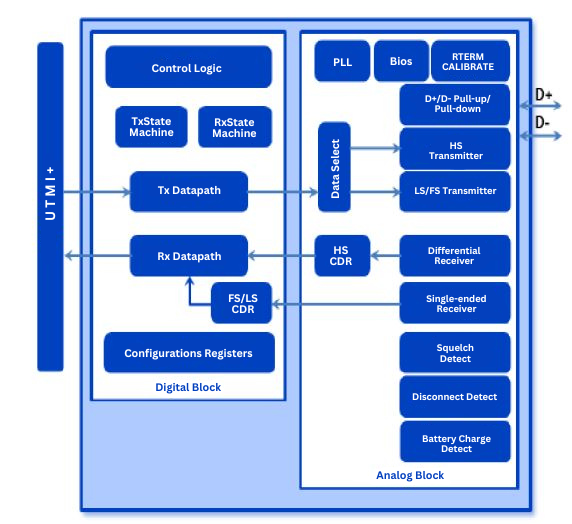The USB 2.0 PHY IP Core is a full physical layer (PHY) IP solution created for excellent performance and low power consumption. The High-Speed USB 2.0 transceiver for usage with hosts, devices, or OTG function controllers is implemented by the USB2.0 IP. The UTMI+ level 3 specification is followed by the USB2.0 PHY IP, which supports both Full-Speed (12 Mbps) and Low-Speed (1.5 Mbps) data rates. 480Mbps of high-speed data flow are provided by combining mixed-signal circuits. The USB2.0 PHY IP transceiver was designed to have a small chip size and low power consumption without sacrificing performance or data throughput with full on-chip physical transceiver solution with Electrostatic Discharge (ESD) protection, a clock generating block provided by an internal PLL, and a resistor termination calibration circuit.

Compliant with USB2.0 and USB1.1 specification
Compliant with UTMI Specification Version level 3.
Supports HS(480Mbps)/FS(12Mbps) /LS(1.5Mbps) modes
All required terminations, including 1.5Kohm pullup on DP and DM, and 15Kohm pull-down on DP and DM are internal to chip
16-bit, 30MHz or 8-bit, 60MHz parallel interface for HS/FS
Serializing for transmitting data stream and Deserializing for receiving data stream
USB Data Recovery and Clock Recovery on receiving
Integrated Bit Stuffing and NRZI encoding for Transmit
Integrated Bit Un-Stuffing and NRZI decoding for Receive
SYNC and EOP generation on transmit packets and detection on receive packets
Internal reference resistor that replaces the external reference resistor
Built in self test for production testing
Supports USB suspend state and remote wakeup
Supports detection of USB reset, suspend and resume signaling
Supports high speed identification and detection as defined by USB 2.0 Specification
Support high speed host disconnection detection
Silicon Proven in TSMC 22ULP
Deliverables
IC Layout Data with Layer Mapping in GDSII
.LEF Files Depicting Placement and Routing Views
Library of Timing and Power Models in .lib Format
Verilog HDL Representation of Circuit Behavior
Circuit Netlist Annotated with SDF Timing Constraints
Design Guidelines and Best Practices for Layout Implementation
Reports Confirming Layout Consistency and Compliance with Design Rules